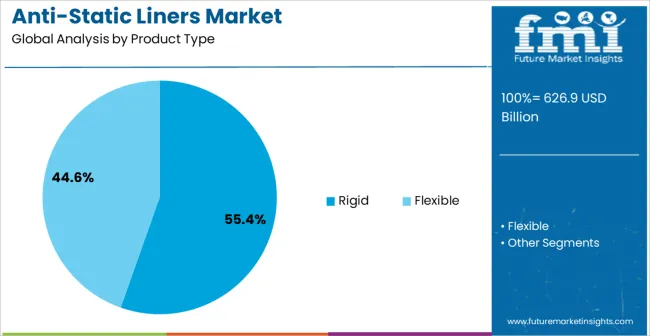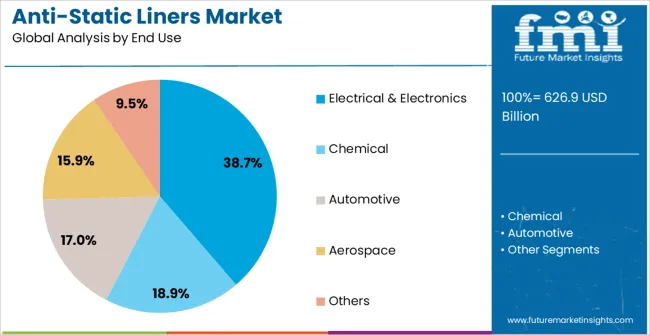The Anti-Static Liners Market is estimated to be valued at USD 626.9 billion in 2025 and is projected to reach USD 1144.1 billion by 2035, registering a compound annual growth rate (CAGR) of 6.2% over the forecast period.

| Metric | Value |
|---|---|
| Anti-Static Liners Market Estimated Value in (2025 E) | USD 626.9 billion |
| Anti-Static Liners Market Forecast Value in (2035 F) | USD 1144.1 billion |
| Forecast CAGR (2025 to 2035) | 6.2% |
The Anti-Static Liners market is experiencing steady expansion, driven by the rising demand for protective packaging solutions across industries where static discharge can damage sensitive products. The growing use of advanced electronics, semiconductors, and precision components has made static protection a critical necessity, creating consistent demand for liners that can prevent electrical discharge during storage and transportation. Manufacturers are increasingly focusing on high-performance materials that combine static dissipation with durability, chemical resistance, and cost-effectiveness.
Sustainability trends are also influencing market growth, with companies developing recyclable and eco-friendly liners that meet both performance and environmental standards. Regulatory guidelines on workplace safety and protection of high-value equipment are further supporting adoption.
The integration of anti-static liners into supply chain operations is improving reliability, minimizing product losses, and ensuring compliance with industry quality benchmarks As industries such as automotive, electrical, aerospace, and pharmaceuticals continue to adopt advanced products, the role of anti-static liners in protecting components is becoming indispensable, ensuring long-term opportunities for growth in global markets.
The anti-static liners market is segmented by product type, end use, and geographic regions. By product type, anti-static liners market is divided into Rigid and Flexible. In terms of end use, anti-static liners market is classified into Electrical & Electronics, Chemical, Automotive, Aerospace, and Others. Regionally, the anti-static liners industry is classified into North America, Latin America, Western Europe, Eastern Europe, Balkan & Baltic Countries, Russia & Belarus, Central Asia, East Asia, South Asia & Pacific, and the Middle East & Africa.

The rigid product type segment is projected to account for 55.4% of the anti-static liners market revenue in 2025, positioning it as the leading product type. Growth in this segment is being supported by its superior durability and ability to provide consistent protection in high-volume shipping and storage environments. Rigid liners are widely adopted in industries that demand high structural integrity, including automotive, aerospace, and electronics manufacturing.
Their capacity to prevent product damage by dissipating static charge effectively enhances product reliability, particularly in environments where sensitive components are highly vulnerable. The long lifespan and reusability of rigid liners offer cost advantages, making them favorable for large-scale enterprises managing continuous production cycles. Additionally, advancements in material design have improved resistance to wear, moisture, and temperature fluctuations, further increasing their suitability across industrial applications.
Companies investing in protective packaging with long-term value and consistent safety performance are strengthening the dominance of this segment As global industries scale production of high-value components, rigid liners are expected to remain the preferred choice, reinforcing their position as a market leader.

The electrical and electronics end use segment is anticipated to hold 38.7% of the anti-static liners market revenue in 2025, establishing itself as the leading end-use category. The rapid expansion of the electronics sector, including consumer devices, semiconductors, and communication equipment, has heightened the demand for protective packaging that ensures safety and compliance. Anti-static liners in this segment are essential in safeguarding circuit boards, processors, and delicate components against electrostatic discharge during transport and storage.
Their adoption is being reinforced by the increasing complexity of electronic devices and the stringent quality standards followed by manufacturers. With the growth of smart devices, renewable energy systems, and advanced automotive electronics, the use of reliable protective liners is expanding significantly.
Moreover, the integration of these liners into global supply chains is ensuring smooth cross-border logistics and reducing losses As the electronics sector continues to innovate and scale production, anti-static liners will play a central role in product integrity, making this end-use segment a key revenue driver in the overall market landscape.
The anti-static liners market is currently valued at US$ 523.43 Billion and is expected to attain a CAGR of 6.2% from the year 2025 to 2035. It is estimated to market a value of US$ 626.46 Billion by the year 2035, owing to the global economic growth.
| Attributes | Details |
|---|---|
| Anti-static liners market (CAGR) | 6.2% |
| Anti-static liners market (2025) | 523.43 Billion |
| Anti-static liners market (2035) | 626.94 Billion |
The anti-static liners market has experienced a growth in demand with the growing trends of safety and awareness. Its property of providing protection from causing damage due to electrostatic discharge markets growth as it is used by many manufacturers such as chemical, electrical etc.
The anti-static liners market has witnessed strong, noticeable growth in the past few years due to the increasing demand for electrostatic discharge protection products. The Anti-Static liner is an ideal packaging solution for the protection of such types of products from damage. The companies involved in the production of anti-static liners are busy innovating their existing products to make this product compatible with a large number of applications.
However, it is already widely used in packaging for electrical and electronic components such as semiconductors, PCBs, etc. The main restraint which could hamper the demand for the Anti-Static liners is the bad quality of the product, which is being manufactured by hundreds of unorganized players due to the highly fragmented market.
Other restraints include the high cost of the additives used for the production of the Anti-Static Liners. Some of the brand owners are not aware of this packaging solution for the electrostatic discharge protection of their products.
However, a recent study showcase that more and more manufacturers are becoming aware and using this packaging solution to save hundreds and thousands of dollars during the shipping and handling process. Due to rising awareness and high demand for discharge protection packaging, there are lots of opportunities for new entrants in the anti-static liners market.

| Country | CAGR |
|---|---|
| China | 8.4% |
| India | 7.8% |
| Germany | 7.1% |
| Brazil | 6.5% |
| USA | 5.9% |
| U.K. | 5.3% |
| Japan | 4.7% |
The Anti-Static Liners Market is expected to register a CAGR of 6.2% during the forecast period, exhibiting varied country level momentum. China leads with the highest CAGR of 8.4%, followed by India at 7.8%. Developed markets such as Germany, France, and the U.K. continue to expand steadily, while the U.S. is likely to grow at consistent rates. Japan posts the lowest CAGR at 4.7%, yet still underscores a broadly positive trajectory for the global Anti-Static Liners Market. In 2024, Germany held a dominant revenue in the Western Europe market and is expected to grow with a CAGR of 7.1%. The U.S. Anti-Static Liners Market is estimated to be valued at USD 237.6 billion in 2025 and is anticipated to reach a valuation of USD 237.6 billion by 2035. Sales are projected to rise at a CAGR of 0.0% over the forecast period between 2025 and 2035. While Japan and South Korea markets are estimated to be valued at USD 31.5 billion and USD 16.9 billion respectively in 2025.

| Item | Value |
|---|---|
| Quantitative Units | USD 626.9 Billion |
| Product Type | Rigid and Flexible |
| End Use | Electrical & Electronics, Chemical, Automotive, Aerospace, and Others |
| Regions Covered | North America, Europe, Asia-Pacific, Latin America, Middle East & Africa |
| Country Covered | United States, Canada, Germany, France, United Kingdom, China, Japan, India, Brazil, South Africa |
| Key Companies Profiled | 3M Company, BASF SE, DowDuPont Inc., Desco Industries Inc., Parker Hannifin Corp., Saint-Gobain Performance Plastics, Elcom (UK) Ltd., Conductive Containers, Inc., Teknis Limited, GWP Group Limited, Kao-Chia Plastics Co., Ltd., and Electrotek Static Controls Pvt. Ltd. |
The global anti-static liners market is estimated to be valued at USD 626.9 billion in 2025.
The market size for the anti-static liners market is projected to reach USD 1,144.1 billion by 2035.
The anti-static liners market is expected to grow at a 6.2% CAGR between 2025 and 2035.
The key product types in anti-static liners market are rigid and flexible.
In terms of end use, electrical & electronics segment to command 38.7% share in the anti-static liners market in 2025.






Our Research Products

The "Full Research Suite" delivers actionable market intel, deep dives on markets or technologies, so clients act faster, cut risk, and unlock growth.

The Leaderboard benchmarks and ranks top vendors, classifying them as Established Leaders, Leading Challengers, or Disruptors & Challengers.

Locates where complements amplify value and substitutes erode it, forecasting net impact by horizon

We deliver granular, decision-grade intel: market sizing, 5-year forecasts, pricing, adoption, usage, revenue, and operational KPIs—plus competitor tracking, regulation, and value chains—across 60 countries broadly.

Spot the shifts before they hit your P&L. We track inflection points, adoption curves, pricing moves, and ecosystem plays to show where demand is heading, why it is changing, and what to do next across high-growth markets and disruptive tech

Real-time reads of user behavior. We track shifting priorities, perceptions of today’s and next-gen services, and provider experience, then pace how fast tech moves from trial to adoption, blending buyer, consumer, and channel inputs with social signals (#WhySwitch, #UX).

Partner with our analyst team to build a custom report designed around your business priorities. From analysing market trends to assessing competitors or crafting bespoke datasets, we tailor insights to your needs.
Supplier Intelligence
Discovery & Profiling
Capacity & Footprint
Performance & Risk
Compliance & Governance
Commercial Readiness
Who Supplies Whom
Scorecards & Shortlists
Playbooks & Docs
Category Intelligence
Definition & Scope
Demand & Use Cases
Cost Drivers
Market Structure
Supply Chain Map
Trade & Policy
Operating Norms
Deliverables
Buyer Intelligence
Account Basics
Spend & Scope
Procurement Model
Vendor Requirements
Terms & Policies
Entry Strategy
Pain Points & Triggers
Outputs
Pricing Analysis
Benchmarks
Trends
Should-Cost
Indexation
Landed Cost
Commercial Terms
Deliverables
Brand Analysis
Positioning & Value Prop
Share & Presence
Customer Evidence
Go-to-Market
Digital & Reputation
Compliance & Trust
KPIs & Gaps
Outputs
Full Research Suite comprises of:
Market outlook & trends analysis
Interviews & case studies
Strategic recommendations
Vendor profiles & capabilities analysis
5-year forecasts
8 regions and 60+ country-level data splits
Market segment data splits
12 months of continuous data updates
DELIVERED AS:
PDF EXCEL ONLINE
Antistatic Brush Market Growth – Trends & Forecast 2024-2034
Box Liners Market Size and Share Forecast Outlook 2025 to 2035
Industry Share Analysis for Box Liners Companies
Pan Liners Market
Pond Liners Market Analysis - Size, Share, and Forecast Outlook 2025 to 2035
Tray Liners Market
Panty Liners Market
Europe Liners Market Size and Share Forecast Outlook 2025 to 2035
Carton Liners Market Size and Share Forecast Outlook 2025 to 2035
Cheese Liners Market
Medical Liners Market Size and Share Forecast Outlook 2025 to 2035
Bladder Liners Market Growth – Trends & Forecast 2025 to 2035
Foam Cap Liners Market Size and Share Forecast Outlook 2025 to 2035
Truck Bedliners Market Outlook- Trends & Forecast 2025 to 2035
Understanding Market Share Trends in Foam Cap Liners
Commodity Liners Market Size and Share Forecast Outlook 2025 to 2035
Patient Recliners Market Size and Share Forecast Outlook 2025 to 2035
Inner Bulk Liners Market Size and Share Forecast Outlook 2025 to 2035
Irrigation Liners Market
Hydrocyclone Liners Market Size and Share Forecast Outlook 2025 to 2035

Thank you!
You will receive an email from our Business Development Manager. Please be sure to check your SPAM/JUNK folder too.
Chat With
MaRIA